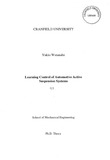JavaScript is disabled for your browser. Some features of this site may not work without it.
| dc.contributor.advisor | Sharp, Robin S. | |
| dc.contributor.author | Watanabe, Yukio | |
| dc.date.accessioned | 2019-01-30T13:49:27Z | |
| dc.date.available | 2019-01-30T13:49:27Z | |
| dc.date.issued | 1997-09 | |
| dc.identifier.uri | http://dspace.lib.cranfield.ac.uk/handle/1826/13865 | |
| dc.description.abstract | This thesis considers the neural network learning control of a variable-geometry automotive active suspension system which combines most of the benefits of active suspension systems with low energy consumption. Firstly, neural networks are applied to the control of various simplified automotive active suspensions, in order to understand how a neural network controller can be integrated with a physical dynamic system model. In each case considered, the controlled system has a defined objective and the minimisation of a cost function. The neural network is set up in a learning structure, such that it systematically improves the system performance via repeated trials and modifications of parameters. The learning efficiency is demonstrated by the given system performance in agreement with prior results for both linear and non-linear systems. The above simulation results are generated by MATLAB and the Neural Network Toolbox. Secondly, a half-car model, having one axle and an actuator on each side, is developed via the computer language, AUTOSIM. Each actuator varies the ratio of the spring/damper unit length change to wheel displacement in order to control each wheel rate. The neural network controller is joined with the half-car model and learns to reduce the defined cost function containing a weighted sum of the squares of the body height change, body roll and actuator displacements. The performances of the neurocontrolled system are compared with those of passive and proportional-plusdifferential controlled systems under various conditions. These involve various levels of lateral force inputs and vehicle body weight changes. Finally, energy consumption of the variable-geometry system, with either the neurocontrol or proportional-plus-differential control, is analysed using an actuator model via the computer simulation package, SIMULINK. The simulation results are compared with those of other actively-controlled suspension systems taken from the literature. | en_UK |
| dc.language.iso | en | en_UK |
| dc.rights | © Cranfield University, 2015. All rights reserved. No part of this publication may be reproduced without the written permission of the copyright holder. | |
| dc.title | Learning control of automotive active suspension systems | en_UK |
| dc.type | Thesis | en_UK |
